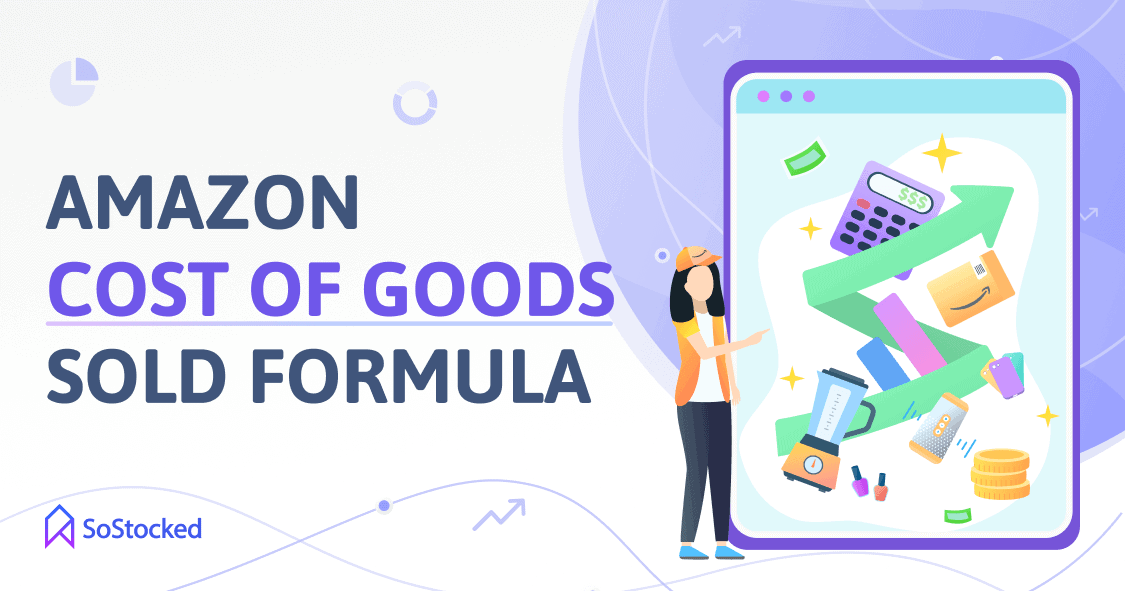
Amazon Cost of Goods Sold Formula
Calculate Amazon COGS + Improve Profit Margins
Calculating your Amazon Cost of Goods Sale (COGS) can be a real pain in the neck, but it’s a necessary evil.
Your COGS tells you what you’re spending your cash on so you can quickly adjust your financial strategy. While you can’t change fixed expenses (raw materials and labor), you can change what you spend to run your FBA business (advertising fees).
For example, if your supplier cost is too high, it means your supplier is probably spending too much on raw materials. And if they can’t keep the costs down, you either have to increase your sale price or find a cheaper alternative.
Knowing your COGS gives you insights into your overhead costs and helps improve your financial savviness. Imagine paying less to produce the inventory you want to sell. It can lead to bigger profits and higher gross revenue without making any adjustment to your sale price.
Read on to learn about the Amazon Cost of Goods Sold formula and how to use it to determine your COGS.
In this Amazon Cost of Goods Sold Formula guide, we’ll take a look at:
- What is the Cost of Goods Sold on Amazon?
- COGS vs Other Similar Terms
- 3 Reasons to Calculate and Track COGS
- Understanding the COGS Formula
- Different Accounting Methods for Determining COGS
- 3 Inventory Valuation Methods
- How to Reduce High Cost of Goods Sold
- Keep Your COGS Down With SoStocked
- Simplify Your COGS Calculations
What is the Cost of Goods Sold on Amazon?
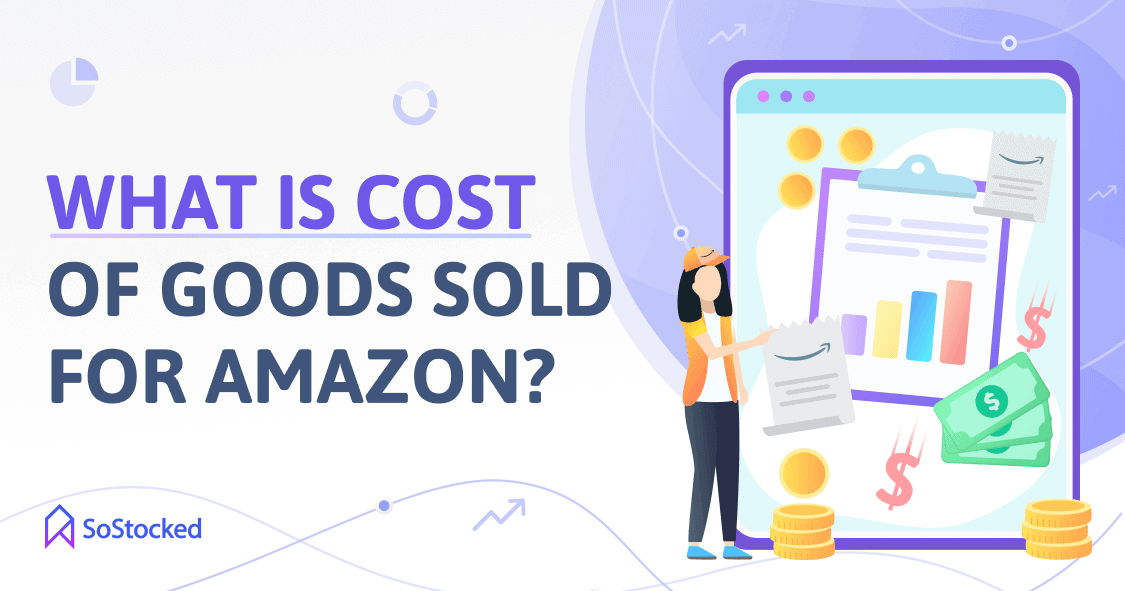
Amazon Cost of Goods Sold (COGS) refers to the costs of turning a raw item into a finished product or sale. It is also an accounting method for matching the cost of a product with its sale to get the most accurate picture of the product’s profitability.
Amazon COGS typically includes:
- Direct costs. Direct costs refer to the expenses involved in producing your inventory, such as procurement, labor, and material costs.
- Indirect costs. These costs refer to the cost of selling your products, such as fulfillment fees, storage fees, shipping costs, and taxes and duties.
These costs are subtracted from your revenue to determine your gross profit (revenue minus COGS) and net profit (revenue minus COGS, cost of business operations, and expenses that occur outside of your company’s daily activities like legal & consulting fees). That’s why tracking this financial metric helps you get a clearer picture of your true revenue figures, profits, and gross margins for a particular month or year.
It is also worth mentioning what COGS is not.
For example, COGS doesn’t include certain operating expenses (OPEX) like utilities, payroll, office rent, and accounting fees. But your OPEX may include direct COGS and expenses related to running and maintaining your business on a daily basis.
COGS vs Other Similar Terms
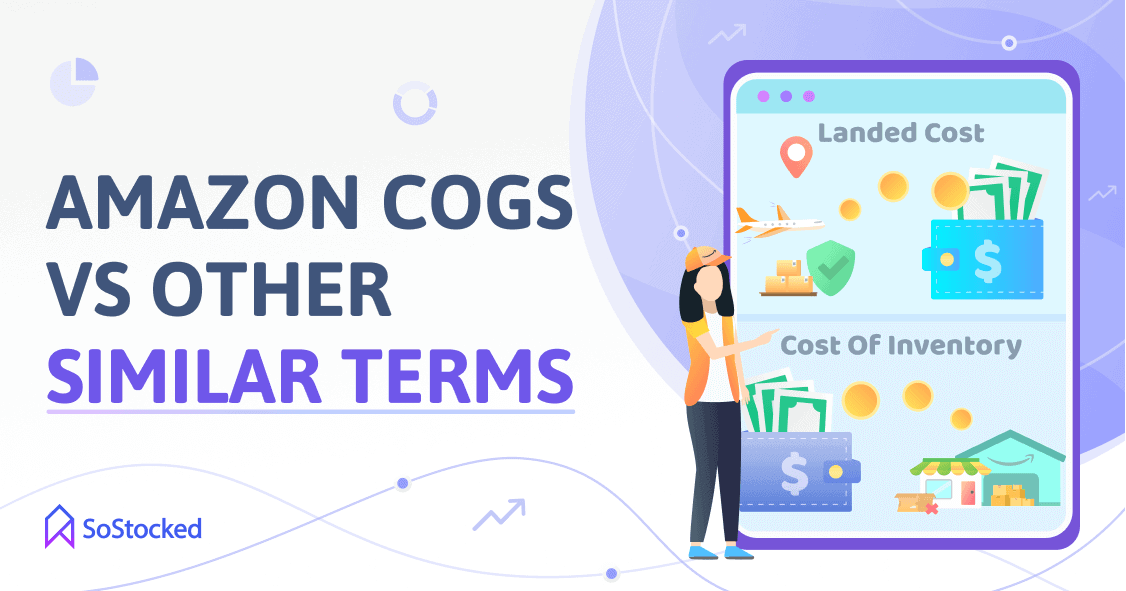
People often interchangeably use COGS with synonymous terms like Cost of Inventory, Cost of Goods, Cost of Sales, Cost of Revenue, and Landed Cost. But these terms may differ from one another depending on who (what type of business) uses them and how they use them in their financial statements.
For instance, retailers may use Cost of Sales on their balance sheets, while manufacturers may use COGS. Both terms mean the same thing fundamentally – the costs associated with producing and delivering a product to customers. When inventory is purchased, it is considered and recorded as an asset on the balance sheet. Once a unit is sold, its cost is removed from the inventory section of the company’s balance sheet and recorded as COGS on the income statement as an expense.
In contrast, service-based businesses like consultants, lawyers, and physicians typically use Cost of Sales or Cost of Revenue on their income statements because they don’t have a tangible product to tie into their operating expenses like retailers or manufacturers do.
You’re probably wondering when to include Landed Cost and Cost of Inventory (AKA Cost of Goods) into your COGS calculation or if they’re different from each other. Well, let’s look at the definition of each term.
- Landed Cost refers to the expenses associated with creating, transporting (from supplier to warehouse), and shipping your product to the customer. Therefore, landed cost not only includes turning raw materials into finished goods, but also any additional fees that come with shipping them, such as shipping insurance, handling and payment processing fees, and import duties. In other words, Landed Cost is much like direct and indirect COGS. This could also mean that you can compute your COGS based on Landed Cost. You can determine your Landed Cost by adding your manufacturing cost, shipping cost, shipping insurance, import duties, and other related fees.
- Also known as Cost of Goods, Cost of Inventory includes ordering, holding (storage), carrying costs (cost of storing slow-moving inventory, thus can be classified as Warehouse Expense), inventory shortage (cost of stockouts), and spoilage costs (obsolete or expired goods). It may also include administrative costs, such as accounting fees. Similar to the other types of costs mentioned above, Cost of Inventory also represents the amount of money it costs you to purchase, transport, and manage inventory. The only difference is that it includes carrying costs (which can appear as Rental Expense on your income statement) and spoilage costs.
If the profit loss from spoilage is significant, you can create a “Loss from Obsolete Inventory” expense account to report it separately from COGS on your income statement. If the damage isn’t substantial, you can apply the cost directly to your COGS as soon as you become aware of it. But whether you record spoilage cost separately or simply include it in your COGS, the impact on your revenue is the same – reduced net income and gross profit.
In sum, you can compute your COGS based on Cost of Inventory IF you want to factor in the costs associated with ordering, holding, stockouts, obsolescence, and carrying slow sellers. Any expenses outside of that would be considered part of your OPEX, therefore excluded from COGS.
3 Reasons to Calculate and Track COGS
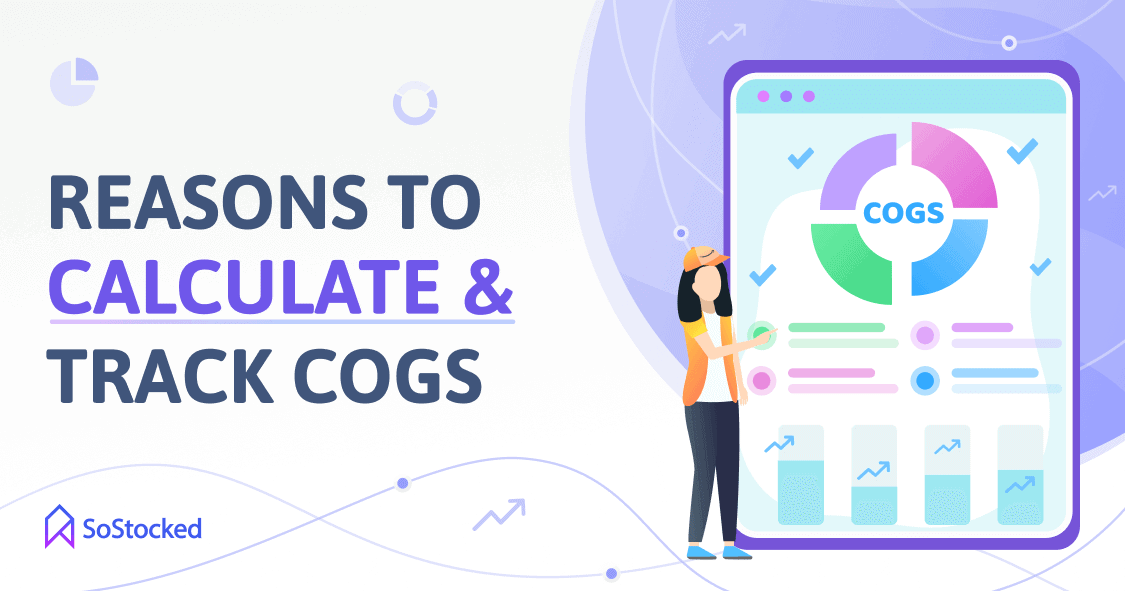
Aside from helping determine your actual costs in manufacturing goods, COGS also:
- Helps identify profitable products. Calculating your COGS will help you figure out which items are most profitable and which are not.
- Helps in building a solid pricing strategy. Accurate product sale price is usually determined, in part by the market and, additionally, by knowing the actual procurement and production fees you’ve paid to create the goods. Determining these costs will put you in a better position to come up with a good price point at which you’d like to sell your goods to not only cover your expenses but also ensure a decent profit.
- Helps your tax accountant to determine inventory assets and expenses for tax reporting. As mentioned earlier, COGS is a business expense that is deducted from your company’s revenue. So, it essentially lowers your taxes. However, the higher COGS is, the lower your net profits will be. Therefore, it’s still important to keep your COGS low to generate a higher profit.
Understanding the COGS Formula
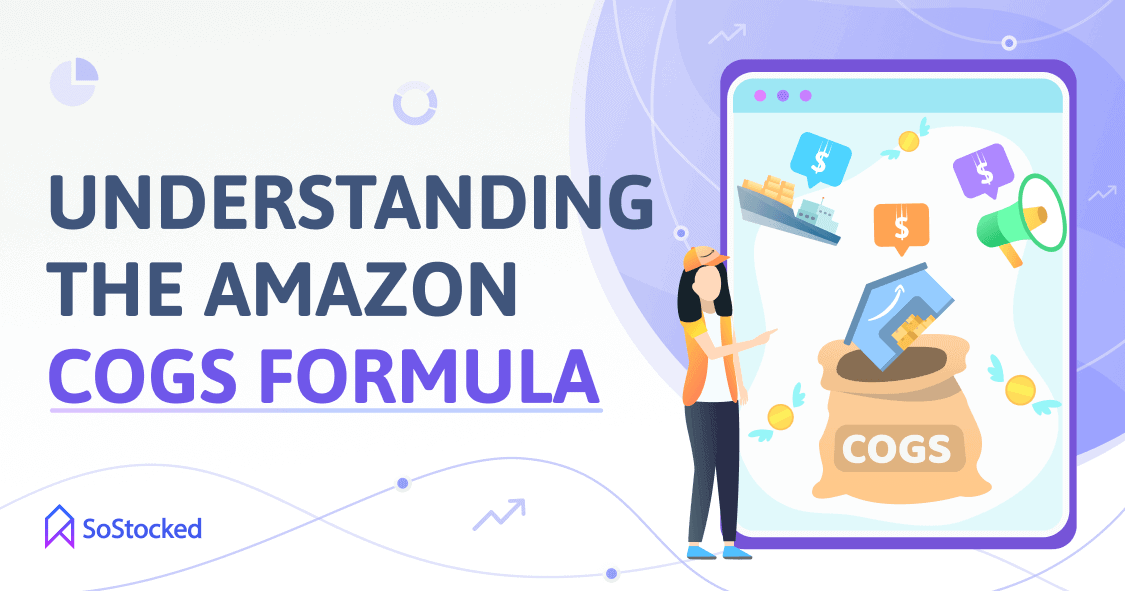
Calculate your Amazon Cost of Goods Sold by using the formula below:
Beginning inventory + Purchases During a Given Period – Ending inventory = COGS
What Goes into COGS?
COGS consists of beginning inventory, additional purchases during a particular period, and ending inventory. Now let’s see what each of these variables means and how they are calculated.
- Beginning Inventory. This term refers to the monetary value of inventory you have in stock at the start of a particular period. It is considered an asset until you sell it so you should record it on your balance sheet as such. When an item is sold, it is reported as COGS on your income statement (AKA Profit & Loss statement). Beginning inventory is calculated by:
(COGS + Ending Inventory) – Purchases = Beginning Inventory
- Additional purchases are then added to the beginning inventory value.
- The ending inventory value refers to the value of unsold products at the end of a given period. It is subtracted from the sum of Beginning Inventory and Additional Purchases to get the final COGS. Ending inventory is calculated by:
Beginning inventory + Purchases – Cost of Goods Sold (COGS) = Ending Inventory
To get your beginning inventory, purchases, and ending inventory numbers, you can use the records from your previous accounting period.
Here’s a quick example:
- Beginning inventory: $20,000
- Additional purchases: $50,000
- Ending inventory: $50,000
$20,000 + $50,000 – $20,000 = $50,000
The formulas above may look simple, but there’s a lot of factors that go into computing beginning/ending inventory and COGS in general. That’s why using the right accounting method for tracking and calculating inventory costs is important. More on that later.
What is the Ideal COGS to Revenue Ratio?
The ideal COGS to sales ratio may vary depending on your business model and market. Some sub-sectors in the retail industry, such as luxury clothing brands, can have tremendously high gross profit margins, but the net margins tend to be lower than the other sub-sectors.
According to an NYU report on US Margins, the average gross margin and net margin of each retail sub-sector is:
| Retail Sub-Sector | Gross Margin | Net Margin |
|---|---|---|
| Online | 42.53% | 4.95% |
| Automotive | 23.06% | 3.84% |
| Building Supply | 34.48% | 7.53% |
| Distributors | 28.39% | 2.74% |
| General | 24.27% | 2.79% |
| Grocery and Food | 26.25% | 2.20% |
| Special Lines | 28.16% | -0.10% |
Based on the report above, a good rule of thumb is to not let your COGS exceed the online retail industry’s average gross margin and net margin, which is 42.5% and 4.95%, respectively. However, those average net margins tend to be quite slim so many sellers who want to expand successfully and actually take home a salary need to target much higher than that.
It would be a good idea to break up your expenses on a product into different types of costs to track them thoroughly. For example, you could create a separate expense account for COGS, Marketing, Operating, and Non-Operating costs on your spreadsheet. Tracking them will help you identify costs that you need to control to maintain a good profit margin.
Want to know if FBA is the best fulfillment method for your new product? Run your calculations and analyze profits with our FBA calculator spreadsheet tool!
What Does Abnormally High COGS to Revenue Ratio Mean?
For Amazon sellers, a very high cost of goods implies:
- You need to look for new product suppliers/manufacturers.
- You also need to look at every cost across the supply chain, not just in production.
- If you’re producing the goods yourself, you need to identify and investigate weaknesses in your manufacturing and shipping processes, such as using outdated systems, employee theft, and inventory discrepancies. Tracking your COGS vs profit over time is also an effective way to detect these problems early so you can adjust accordingly before the product or business becomes unprofitable.
Related: Amazon Inventory Turnover: Understand, Calculate and Automate
Different Accounting Methods for Determining COGS
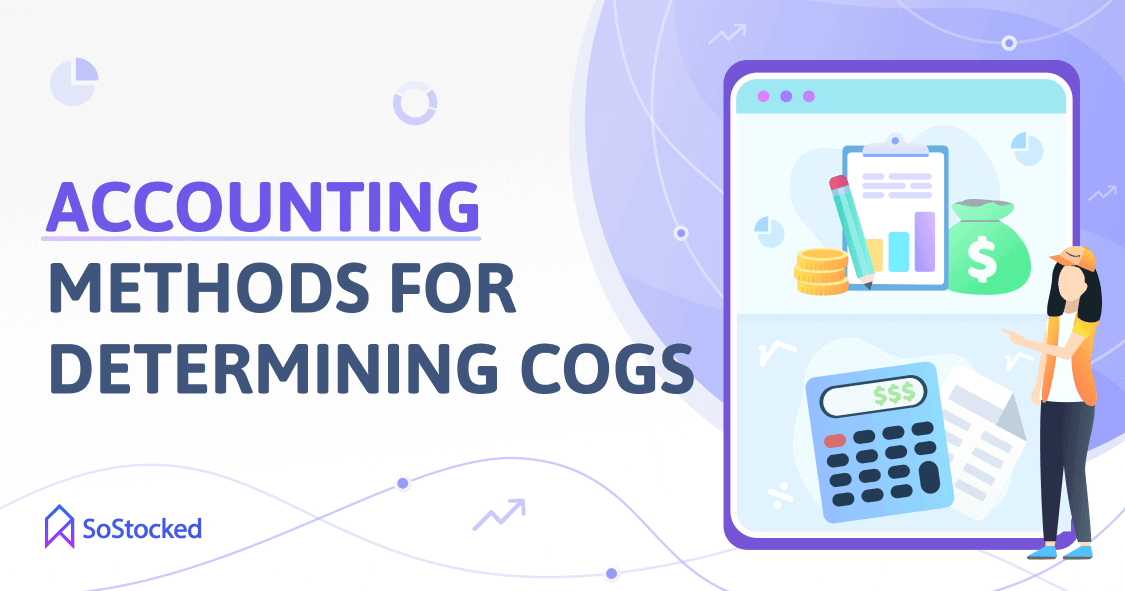
There are two ways of accounting for COGS:
- Cash basis accounting
- Accrual accounting
Many sellers use the accrual accounting method for determining Amazon COGS as it gives a more accurate picture of their company’s financial health. It’s also beneficial for sellers who are planning on selling their business at some point. Be sure to always refer to your accountant for expert advice on this matter.
Cash Basis Accounting
Cash basis is the simplest accounting method for recognizing revenues and expenses at the time cash is received.
In this accounting method, COGS is recognized the moment you purchase or receive your inventory.
Suppose you pay your supplier $20,000 for 2,000 units of premium baseball caps. In that case, you would expense this amount right away.
However, one of the disadvantages of cash basis accounting is that it doesn’t provide an accurate insight into your profits. Imagine you have months where you make expensive purchases, using cash basis may make it look like you lost a huge amount of money one month and made a ton of profit the next as it doesn’t assess the inventory as an available financial resource that can be utilized. Cash basis accounting for an inventory-based business provides a false picture of the state of your business.
There isn’t a precise way to know your actual profits if you’re using the cash basis method, which leads us to the next topic.
Accrual Accounting
Accrual accounting is a method for recognizing payments (or expenses) when a transaction occurs rather than when a payment is received. This method follows the matching principle, which means both expenses and revenues should be recognized in the same reporting period.
In other words, rather than counting your purchase orders as an expense the moment you buy them (cash basis accounting), you track these purchase orders as an inventory asset on your books and only expense the units you have bought as you sell them (accrual accounting).
For example, you bought another batch of baseball cap inventory in April but you didn’t start selling the units until September. In that case, you would only count the cash you paid for that inventory as an expense in September: the month you start selling each unit on Amazon.
Let’s look at an example:
- Type of product: Reusable dish scrub
- Each unit costs you $0.50 (AKA production cost).
- In April, you purchase 2,000 units of reusable dish scrubs.
- Based on your projected sales, you will sell 170 units at a $3 price point each month.
- Revenue: 170 x $3 = $510
When you use accrual accounting, you would initially report an asset of $1,000 ($0.50 x 2,000 units) on your financial statement in April in the form of inventory value. This value would be reduced by $85 ($0.5 cost x 170 units sold), and that $85 is your expense or COGS. Your gross profit (revenue minus COGS) would be the amount you get after deducting $85 from your revenue, i.e., $510 – $85 = $425.
So, aside from showing expenses, COGS also shows you the profit you’ve made within a specific time period, which in this example is $425 ($510 revenue – $85 COGS).
In sum, accrual accounting gives you a clearer picture of how much profit you’re making each month. Even if sales didn’t start coming in the first month, you don’t have to recognize your inventory as expenses right away. You would only expense your inventory at the time of sale.
However, this method requires a more hands-on approach, as it involves accounting for the units you’ve bought as you sell them. The good news is that you only have to do accrual accounting on a monthly basis so you don’t have to expect it to take up your whole life. If you have multiple products to track, though, expect things to get more challenging.
That’s where bookkeeping (whether done through software or spreadsheets) and inventory management systems come in handy. Some systems come with built-in inventory valuation and COGS reporting tools that allow you to export data easily.
Consider investing in tools that will simplify this process for you so you don’t end up calculating COGS all day.
Pro tip: Check out how SoStocked, a customizable inventory management software, can help you track and calculate your inventory value on any given month or year which is extremely helpful for accounting and profitability purposes.
3 Inventory Valuation Methods
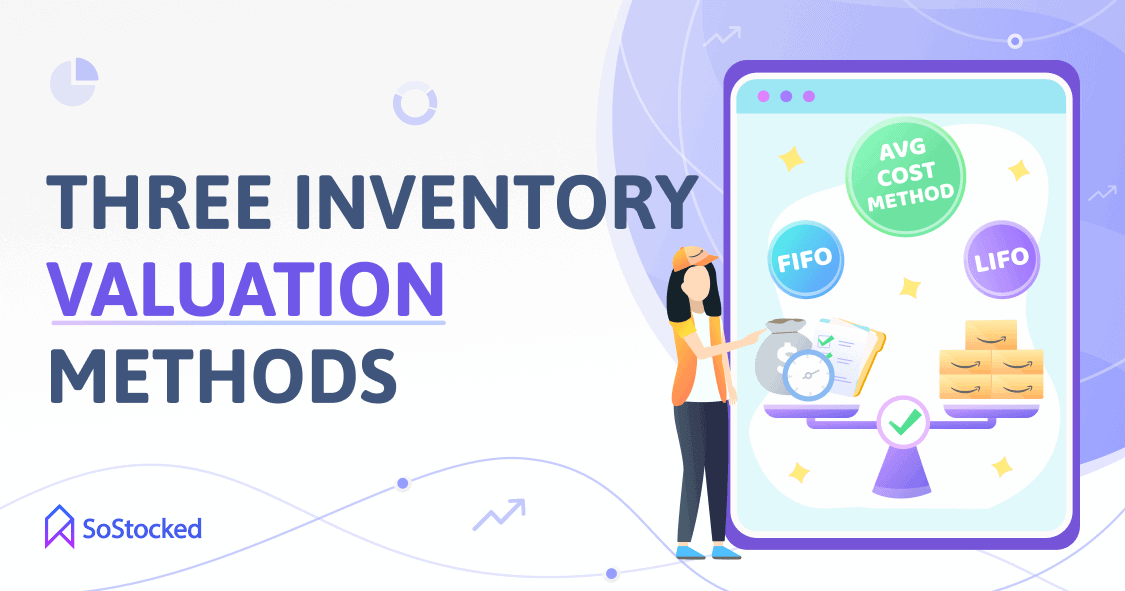
Now that you have a better understanding of COGS and what accounting principles to follow, the last step is to choose the right inventory valuation method for your business. Your COGS calculation can change depending on the valuation method you choose.
There are three ways to determine the value of your inventory:
- FIFO (First In, First Out)
- LIFO (Last In, First Out)
- Average Cost Method
Let’s use the sample order report below to demonstrate how to calculate COGS using each of these methods.
| Month | Unit Amount | Cost per Unit | Total Cost |
|---|---|---|---|
| April | 100 | $5 | $500 |
| May | 100 | $6 | $600 |
| June | 100 | $7 | $700 |
FIFO (First In, First Out)
FIFO is the most common inventory valuation method, in which products that are manufactured or acquired first are sold or used first to avoid obsolescence.
As products are sold, the cost of manufacturing and selling the product must be reported as an expense. It is also assumed under FIFO that the cost of inventory you bought first will be recognized first.
And since the inventory has been sold, and thus, removed from your ownership, the value of your total inventory also decreases.
To determine COGS using FIFO, get the cost per unit of your oldest inventory and multiply that cost by the amount of inventory sold.
Cost of Oldest Inventory x Amount of Inventory Sold = COGS
Quick example:
If 100 units were purchased for $5 each and you sold all 100 units in April, your COGS would be $500.
But sometimes the cost fluctuates, so that should be taken into account, too.
Let’s say you want to calculate your COGS in May and you’ve already sold 120 total units between April and May, the first 100 units in April, and then another 20 units from your May inventory.
Note that over the course of two months, the cost per unit price increased from $5 (in April) to $6 (in May). Since the $5 rate only applies to your oldest inventory, the 20 units (out of the 120 units sold) will have to use the new $6 rate to keep your COGS for the month of May up to date.
So, if you factor in your additional inventory purchases and their new rates, your COGS would be:
(Cost per unit of Older Inventory x Amount of Inventory Sold) + (Cost per unit of New Inventory x Amount of Inventory Sold) = COGS
-or-
120 units sold with FIFO = ($5 x 100) + ($6 x 20) = $620
LIFO (Last In, First Out)
The opposite of FIFO, LIFO method assumes that the last item purchased must be sold first. Some companies use this method when the cost of inventory is increasing due to inflation and other factors. Since the more expensive items are sold off first, this also means that the taxes will be lower, which could result in considerable savings.
To calculate COGS using LIFO, determine the cost of your most recent inventory and multiply that by the amount of inventory sold.
Cost of Most Recent Inventory x Amount of Inventory Sold = COGS
Quick example:
Let’s say it’s June now, and your cost per unit has recently gone up from $6 (May) to $7 (June). You have sold 120 units so far and want to update your COGS using the LIFO method, which means you’ll have to use your most recent cost of inventory.
Your LIFO COGS per the same above scenario as used in FIFO would be:
(Cost per unit of Newer Inventory x Amount of Inventory Sold) + (Cost per unit of Older Inventory x Amount of Inventory Sold) = COGS
-or-
120 units sold with FIFO = ($7 x 100) + ($6 x 20) = $820
Using the LIFO method may take a huge bite out of your profit, but it will reduce your taxes.
Using FIFO versus LIFO, in this example with rising costs, will mean that your LIFO COGS costs for write-off at year-end will be higher and your inventory value will be lower than with FIFO.
Again, using the above examples, we can see the difference between LIFO and FIFO in terms of inventory value.
FIFO Inventory Value – $1800 (April + May + June inventory costs) – $620 (120 units sold) = $1180
LIFO Inventory Value – $1800 (April + May + June inventory costs) – $820 (120 units sold) = $980
When you determine the difference between your FIFO Inventory Value calculations ($1180) and LIFO Inventory Value ($980), you’ll get what accountants call the LIFO Reserve.
LIFO Reserve = (FIFO inventory) – (LIFO inventory)
$1180 + $980 = $200
Note: LIFO is not legal in all countries. The US is one of the few countries where it is currently legal, at the time of this writing, and allows businesses to switch from FIFO to LIFO, but it’s best to check with your accountant or tax professional before making any changes to your financial practices as you must follow certain transitions guidelines to ensure it is safely done.
Average Cost Method
Utilize this method to determine the average cost of each product you purchased over a particular period of time and use that figure to calculate COGS.
The formula is:
(Average Total Production Cost / Total Inventory Count Purchased in a Given Period) x Total Number of Units Sold in a Given Period = COGS
Using the same sample report we’ve used previously, let’s say you sold 200 out of 300 units over the last three months and now want to find out your COGS using the average cost method, your calculation would be to look at the total spent on inventory and to average out the cost per unit.
If you spend a total of $1,800 on 300 units of inventory, the average price per unit would be $6 per unit.
($1,800/ 300) x 100 = $600
This product also leaves you with a final inventory value of $600, where 100 is the total number of unsold units x $6 ($1,800/300).
Sure, it’s the easiest valuation method, but like cash basis accounting, it’s also the least accurate.
How to Reduce High Cost of Goods Sold
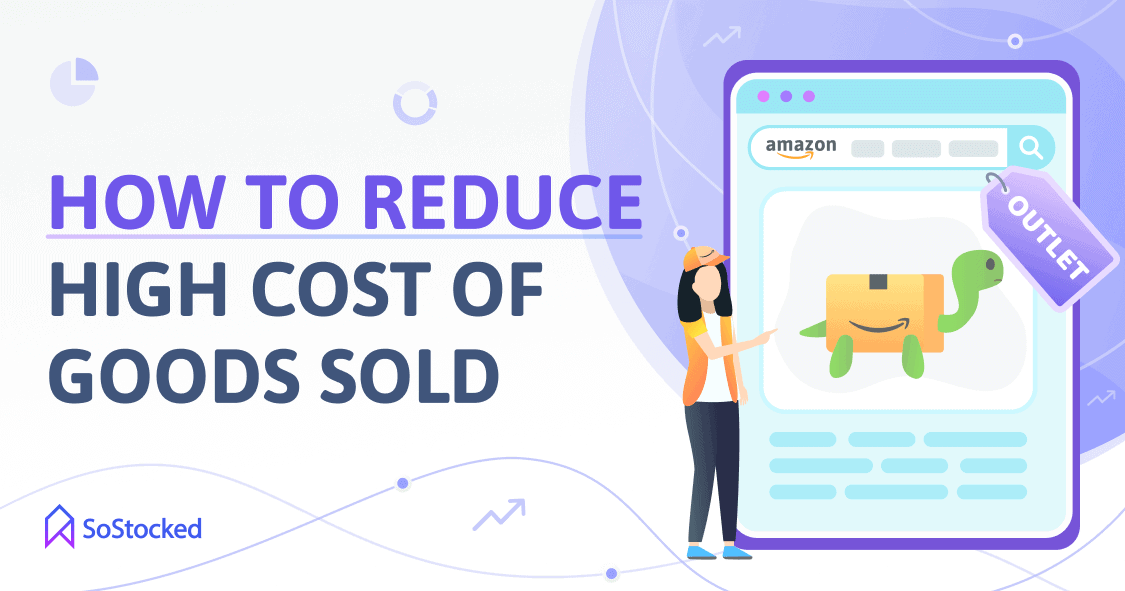
Worried about your higher-than-average COGS? Here are some strategies for reducing it.
Identify and Move Unprofitable Products
As mentioned earlier, carrying costs and spoilage costs are inventory expenses that can increase your high COGS to revenue ratio. For instance, keeping your stale inventory at Amazon costs you in long-term storage fees, which are then added as an expense to that inventory’s COGS. So aside from not making any sales on that aging inventory, you also lose money from letting it sit in your warehouse for months.
So, you need to turn your inventory over as quickly as possible to ensure good profits and to keep costs low.
Some of the most effective ways to get rid of slow sellers are:
- Offering them on Amazon Outlet Deals
- Creating your own flash sales
- Liquidating them
- Get rid of stale or obsolete inventory by creating an Amazon disposal or removal order
Related: Amazon Excess Inventory: Why It’s Bad and How to Reduce It
Improve Forecasting Accuracy
Costs associated with stocking out and overstocking can significantly increase COGS. When you stock out, it could cost you a lot of money to expedite the production and shipping of your additional inventory. Carrying excess units also comes with additional costs such as accumulated storage fees. The longer they sit in your warehouse, the higher your costs will be.
Use inventory forecasting software to improve forecasting accuracy. In SoStocked, you can factor a lot of variables into your forecast, such as:
- Past sales
- Seasonality
- Restock limits
- Min/Max Restocking
- Future marketing plans, e.g., Lightning Deals, sales campaigns, etc.
- Growth trends
- Lead times, including express lead times for express air shipping in the event of emergencies
You can also remove sales spikes, stockouts, and Blackout Dates from your calculation so you can get the most accurate prediction possible.
Related: How to Automate Amazon Inventory Forecasting for Accurate Reordering
Find Lower Cost Materials
Raw material costs are one of the main contributing factors to high COGS. In the last few months, we’ve seen a steady increase in material costs driven by high customer demand and reduction in supply due to supply chain issues, resulting in shortages.
According to WorldBank’s Commodity Markets Outlook, the prices of cotton, rubber, and other agricultural raw materials increased by up to 18% over 2020 rates. The prices are expected continue rising, averaging at another 10% higher in 2021 before stabilizing in 2022.
With that in mind, now’s the best time to shop around for raw materials from different suppliers or, if you have the capital available, to find out if ordering raw material in bulk for discounted price breaks makes sense for your business. Consider this across all facets of your production from product parts to inserts to packaging and cartons. You might also want to consider replacing some elements of your finished product with more affordable alternative materials.
For instance, you may think that most customers always prefer metal to plastic, but that may not be the case. Of course, this doesn’t mean you have to sacrifice your product’s quality. You could try looking at tougher and sturdier plastic materials that are available in the market today, such as ABS and polypropylene.
Minimize Supply Chain Costs
Shipping delays? Missing units? Receiving your goods in poor condition? There are costs associated with these logistical challenges, and they can quickly add up to overspending if you don’t track them carefully.
For example, inventory shrinkage (damaged, missing, or stolen goods) decreases your ending inventory, and thus, increases your COGS to revenue ratio.
Ending inventory is the value of goods that are still waiting to be sold and held by your company at the end of an accounting period. When some items in your inventory are missing, they may be expensed directly to your COGS account. And since they’re no longer an asset that you could profit from, the value of your ending inventory also decreases, which could translate into lower profit margins.
Another example is when you pay for 5,000 units but are only able to sell 4,750 in a given period, the remaining sellable units could lose their market value the longer they stay unsold.
When the cost per unit increases, your older inventory’s value drops below its book value (the value of an inventory asset based on its balance sheet account balance).
In this case, you have to do an inventory write-down to either reduce the value of ending inventory for the given period (under cash-basis accounting) or have some inventory reserve to account for future losses (under accrual accounting) and recognize that expense (thus increases COGS) in advance to match your costs with expected profits. Either way, inventory write-downs due to inventory shrinkage can impact your balance and income statements, and ultimately affect your net profit.
Minimize Inventory Shrinkage
It’s best to use a good inventory tracking system to keep an eye on your products as they move through the supply chain. When ten units go missing, you can quickly file for reimbursement at Amazon or open a case with your carrier. This way, when your carrier loses your shipment you’ll be able to get back some of your capital and reinvest that money in your business.
There could also be plenty of time wasted in your reordering process, i.e., you don’t have real-time access to your inventory levels. So when you think it’s time to reorder, you go through multiple spreadsheets to find out how much you need and it ends up consuming your day and you sometimes find you should have ordered a week ago.
The extended time spent on reordering could be reduced through automation, which means you’ll have more time to work on marketing and expansion tasks. In SoStocked, you can set your minimum and maximum days of stock for more accurate reordering. SoStocked pulls data directly from the Amazon API twice a day for the most up-to-date information and alerts you when it’s time to replenish stock to avoid ordering too late.
Related: 11 Ways Amazon Inventory Trackers Improve Inventory Management
Negotiate Lower Rates
The rising cost of producing and shipping products from China to the US alone is enough reason to look into getting your rates reduced.
Sometimes it makes sense to revisit the conversation around unit pricing, shipping options or warehousing fees with your suppliers, freight forwarders and warehouses respectively. Otherwise, you may find yourself shelling out more cash than you can afford, which also means higher COGS. Reduce these expenses, and your cost of goods sold will decrease, too.
For example, you could ask your 3PL partner whether their warehouse labor fees are broken down into increments of time or if they roll up to 1-hour minimums. If it only takes them 10 minutes to pack and ship a unit out of their warehouse, are they charging you $40/hr in 15-minute increments or will you pay the full price ($40) for that 10 minutes of time? You could save some money by reviewing your warehouse structure fee and asking for lower rates!
Many Chinese suppliers are willing to give you a lower rate if you ask for it and can make it mutually beneficial for them as well.
Examples of deals you could ask for are:
- Bulk order discounts
- Lower per-unit prices
- Lower minimum order requirements
- Lower rates in exchange for upfront payments
- Lower interest rates for quicker repayments if you’re using a loan to pay the supplier
Remember, negotiation involves two parties trying to settle on a price. Some suppliers will be willing to give you excellent discounts to close the deal immediately, while others will want something in return. For example, a supplier may increase the Minimum Order Quantity in exchange for a lower rate.
The bottom line is to think hard about what you’re asking for. Can you hold up your end of the bargain? If things go south, can you handle the negative consequences of your negotiations?
Related: Amazon Supplier Negotiation Strategy
Keep Your COGS Down With SoStocked
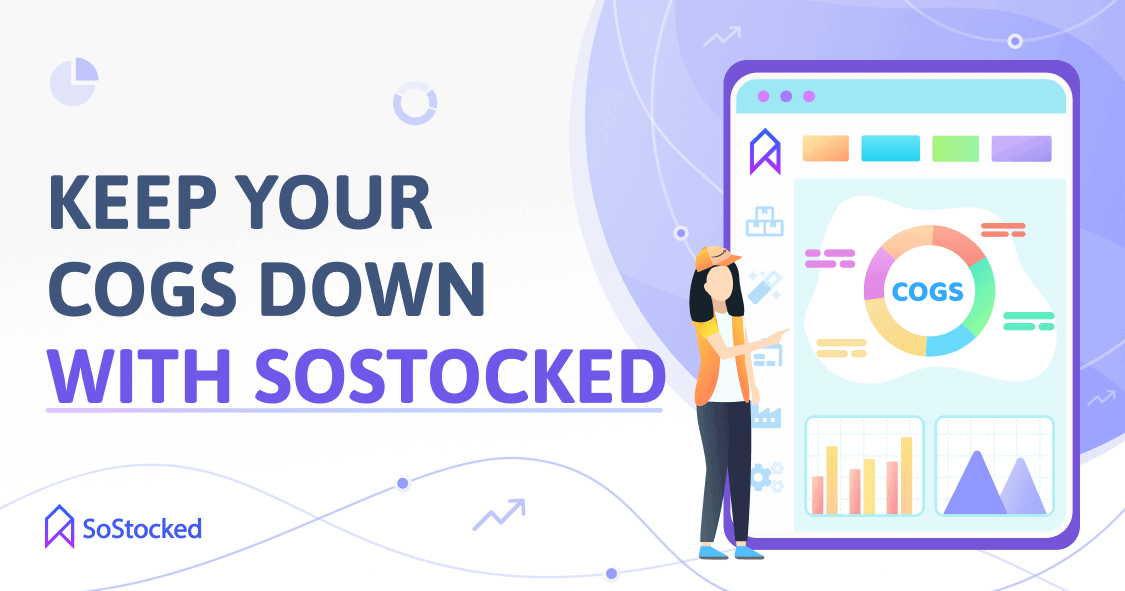
SoStocked has loads of tools and features that you can use to reduce inventory pains like inventory forecasting challenges, stockouts, overstock, and late reorders, which consequently reduces costs associated with managing inventory.
Inventory Valuation and COGS Report
Create an Inventory Valuation Dashboard to track the COGS for each product and export Inventory Valuation and COGs Report.
Forecast Modeling
Factor in your past sales and future marketing plans (e.g., planned sales events, seasonality, growth trends, and deals) to generate a highly accurate sales projection. Accurate forecasts help to minimize future stockouts and ensure precise reordering.
Min/Max Restocking
Set your minimum and maximum days of stock for both FBA and your third-party warehouse to automate your reordering process. This way, you’ll know exactly when and how much inventory to purchase for each warehouse or fulfillment center.
Overstock Dashboard
Keep your inventory levels healthy by identifying and managing excess units with our Overstock Dashboard. Knowing which products you are overstocked on so you can proactively work to move it is key to minimizing storage costs and improving sell-through rates, allowing you to scale by recovering cash from stale inventory to put back into your business to launch new products and put more money into marketing.
Liquidations Dashboard
Use our Liquidations Dashboard to identify extremely slow sellers that are likely to see your profit eaten up in long-term storage fees and holding costs. Once identified, you can quickly decide whether they’re worth creating flash sales for or sell off to liquidators. Either way, you’ll be freeing up space that you could use for faster selling, more profitable products and eliminating holding costs that are hurting your business.
Slow-Selling ASINs Reporting Tool
Minimize your excess inventory risk by tracking all your slow-moving products. Turn the data from our Slow-Selling ASINs report into valuable insights so your team can come up with a plan to boost product sales and revive those ASINs or sell them out quickly and move on.
Bonus: Join my free live webinar for more inventory management tips!
Simplify Your COGS Calculations
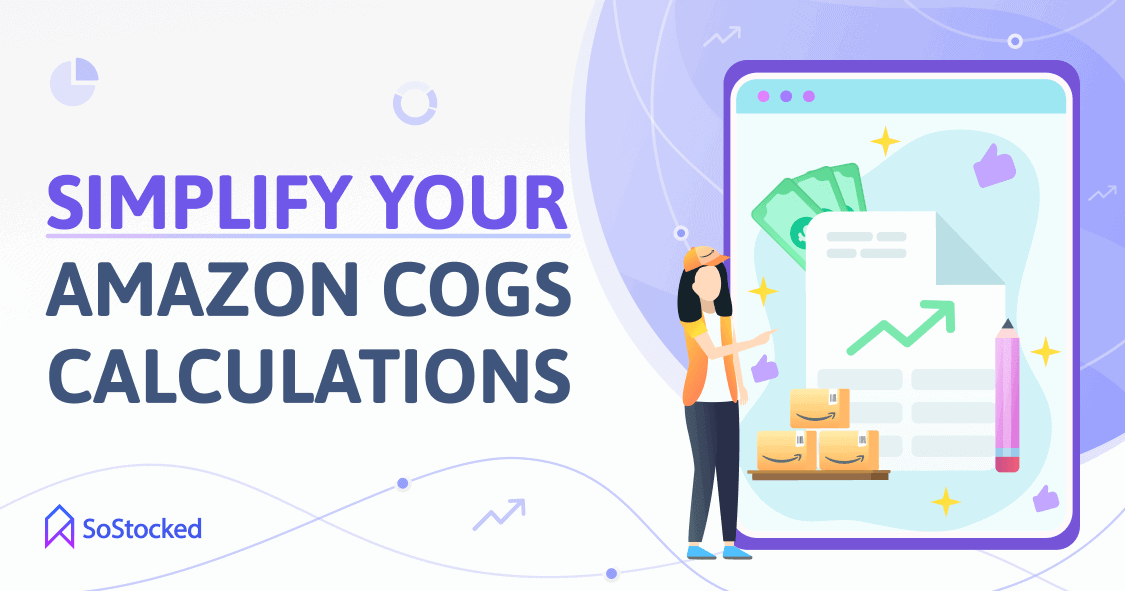
Increasing your visibility into your revenue and expenses empowers you to make data-driven decisions. Armed with this knowledge, you can confidently draw up plans to scale your company’s profitability.
When calculating your Cost of Goods Sales, follow the right accounting principles and choose the best inventory valuation method for your FBA business. Consider making this process simpler by using advanced inventory management systems like SoStocked.
Our software has an Inventory Valuation and COGS report that allows you to gather data for your financial analysis and automate COGS calculations. Additionally, features like Forecast Modeling and Customizable Seller Dashboards help improve your forecasting accuracy and overall inventory management efficiency.
Need more information?
- Send Message: We typically reply within 2 hours during office hours.
- Schedule Demo: Dive deeper into the nuances of our software with Chelsea.
- Join Live Upcoming Webinar: New to Amazon inventory management? Learn three inventory techniques you can implement right away.
 Start Your Free Audit
Start Your Free Audit